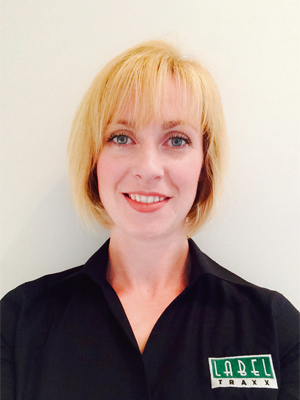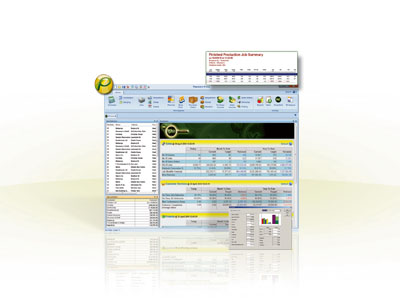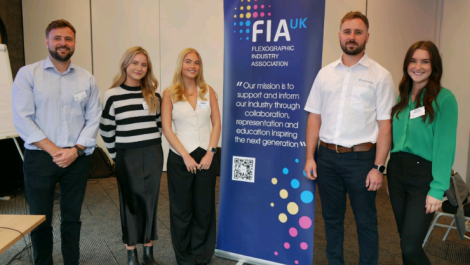Andy King, Shuttleworth
Management information systems have evolved from simple production data gathering to running sophisticated, automated workflows. By Nessan Cleary.
Traditionally, management information systems, or MIS, have been all about gathering information on the different parts of a business from stock management to press stoppages. As Steve Richardson, sales director for Optimus, explained, ‘MIS is about cold hard facts so that you can make informed decisions.’
MIS vendors have become adept at connecting their software to the various systems throughout a print company in order to bring all that information together to give an overview of how that company is running. So, essentially an MIS is a database – most use some form of SQL – with an interface and a set of rules or algorithms that govern how that data is used.
There are a number of MIS designed specifically for the printing sector, though only some of these can also cope with the requirements of packaging printers. Jenny Whittle, commercial manager of Label Traxx, explained, ‘The label and packaging sector generally has a lot more repeat business so it’s much more important to have a product-led workflow so that you have all the same information going down to produce the same quality on re-orders so they know exactly what anilox they used and how to mix the ink and so on.’
Most customers start off with a manual approach, typically Excel spreadsheets and hand-written forms but reach a point where this becomes unworkable as the company grows. Ms Whittle said, ‘It’s the speed that it takes for someone within the business being able to check what’s happening with an order and what’s an accurate price and having that information to hand quickly that gets people to think about their MIS.’
She said that the main strength of the Label Traxx MIS is that it is tightly focused on the labels sector, adding, ‘It’s able to accurately price things which a general system couldn’t cope with. Being able to store other data within Label Traxx, such as customer approval, tender information and price lists, means that users don’t have to rifle through their emails to find the purchase orders.’
Just about all of these MIS take a modular approach with most having a core set of modules; beyond that customers specify the modules that fit with their business model.
Lee Ward, sales director for Tharstern, said that the most popular modules are CRM and Estimate Pro as these drive the sales side of a print business. He added that JDF control, purchase order and stock control are also often specified, noting, ‘Fulfilment is common for packaging because a lot of packaging companies will manufacture vast amounts and keep a certain amount in storage ready for call off. We have multiple stock warehouse features so they can pick and pack based on the barcode readers that are available to warehouse operators.’
According to Mr Ward companies are also increasingly asking about linking to web to print systems. Tharstern does sell its own e-commerce module, E-Print Pro, but also uses the cXML standard to connect to other systems. He noted, ‘We have bi-directional communication with a lot of other web to print software. We can also link to customers’ purchase order systems. Our customer’s customer can supply data files and we can stream that to the MIS to monitor the order into the MIS as well.’
Tharstern’s main MIS is Primo, an enterprise level system that runs on a Microsoft SQL server database. There is also an entry-level version, Primo Lite, which uses Microsoft’s free SQL Express. Mr Ward said that it is easy to upgrade to the Enterprise level, adding, ‘It’s the same product, it’s just licensed differently.’
MIS vendors have always been good at integrating their products with other systems to collect data directly without relying on operators to input information. But over the last 10 years or so this capability has led these MIS to take on a different role, helping to connect disparate systems together to create a joined-up workflow. This stems from the Job Definition Format (JDF), which allows information about each job to be sent to all the different systems involved in its production.
The JDF specification also allows for information to be sent back – the Job Messaging Format (JMF) – to say, for example, that the plates have been made or the press is ready to print. Mr Ward pointed out that one customer, Kingston Carton in Yorkshire, has used this to connect the Tharstern MIS to its press, ‘They are looking to get JDF messages back from their Manroland press to measure operational efficiencies.’
Most MIS vendors report that JDF has taken far longer than expected to establish itself, partly because printers only gain JDF capability when they update their capital equipment. But Andy King, joint managing director of Shuttleworth, said, ‘The last 12 to 18 months have seen a big take-up from MIS to pre-press and to press with finishing still to catch up.’ But he warns that those printers that have used JDF have found that it takes away some of the flexibility between the estimating department and the press room. Mr King explained, ‘With a JDF workflow you have to get the estimate right or you are losing out on the information that will come back. So if you want to have a JDF workflow then the information has got to be right from the outset. And it has to generate a price that will get the printer the order in the first place.’ He added, ‘It’s taken people a while to work out that the JDF should tell them what their production costs are going to be and then work out how much to sell that for. Also the rest of the business has got to accept that they have to use that information or change the source of that information rather than just go off and do it a different way.’

Jenny Whittle, Label Traxx
Mr King said that software vendors do use JDF in the background, noting, ‘We use JDF to link operations to collaborate with other suppliers like Esko.’ But he added, ‘There are tools within the Esko workflow system that allow people like us to create links using XML rather than JDF. They do have a JDF option but the XML route is the preferred option because you can be very precise about how we make connections to their system.’
Other vendors report similar experiences. Thus Mr Ward said, ‘We work with AG CAD’s Kasemake software to achieve the same level of integration but using their API to integrate their CAD calculation with our system rather than JDF.’
Over the last year or so most MIS vendors have concentrated on extending their software to work with tablets and other mobile devices. Mr King said, ‘At the beginning of this year, we started to introduce mobile stock control. Now rather than traditionally picking items you can do that from a mobile device. Being able to make the picking in real time without having to make a list and go back to it saved one company up to three hours a day in terms of administration time. Furthermore, everything is on the system so people know what’s happening with their stock throughout the whole business.’
EFI has also prioritised mobile computing with the latest release of its PrintSmith Vision MIS. This is a browser-based system that has been designed to be easy to run, particularly for smaller companies. That said, it includes all the standard tools, such as estimating, point of sale, account management, production management, receivables and sales analysis tools. Version 3 features new HTML5 mobile views to let users see work-in-process, view job statuses or check arriving shipments remotely. There are also new dashboards to display information specific to the logged-in user, such as orders entered by that user and a list of pending estimates that can be opened from the dashboard and converted into orders.
EFI is by far the biggest player in the MIS market, having bought several smaller MIS developers giving it a global footprint where most MIS vendors are quite regionalised. EFI’s main offering for the packaging market is the Radius MIS, but it also sells Monarch, which is really an Enterprise Resource Planner for large multi-site organisations and Pace for medium-sized companies.

Tharstern’s Primo MIS is an enterprise level modular system
Over the last couple of years, Optimus has redeveloped its original 2020 MIS into a leaner system called Dash, which Mr Richardson said is very flexible, explaining ‘It’s process driven and can take its lead from the customer.’ Optimus has been working on integrating tablets into print production so that operators can see the progress of a job through the system. Recently the company has announced Cloud Mobile, which is designed to allow sales staff to provide quotes when away from the office and to add job orders directly into the production system. Mr Richardson added, ‘We are doing some integration work with XMPie and they have a wider workflow product with prepress and imposition.’ He said that another strength of Dash is its ability to handle a range of products including non-print items.
Ultimately, an MIS is all about automation. This can be for relatively simple tasks of estimating or generating an invoice, as well as understanding all the costs involved in a given job, or throughout the business as a whole. But this automation can also extend into running the entire production, from pre-press and printing through to finishing. There aren’t many examples of this right now, particularly in the packaging sector, but most MIS vendors have spent years laying the groundwork for this level of integration with other systems and expect this to become more common over the next few years.
The trend for shorter runs and versioning will accelerate this. Jenny Whittle added, ‘Particularly in the digital world, where you have a lot of versions so being able to enter all the product information where you might have different versions, like different flavours of ice cream, can take someone a lot of time, even more so if you have different languages as well.’
So we are seeing MIS evolve, from gathering management information to becoming part of a joined-up production system. It is tempting to see these two roles as separate but really they are fused together, like two sides of a coin, and this will become increasingly obvious as the different systems start to become more integrated.






